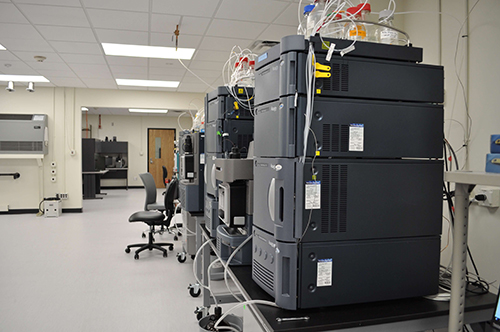
Close-up of instruments in the newly renovated Mass Spectrometry and Metabolomics Core facility. Courtesy photo.
Michigan State University’s Research Technology Support Facility, or RTSF, consists of five analytical cores that offer researchers the tools they need to perform world-changing life science, from cryo-electron microscopy to advanced genome editing.
Recently, the Mass Spectrometry and Metabolomics Core located in the College of Natural Science’s Department of Biochemistry and Molecular Biology, or BMB, completed nearly $2.2 million in renovations, allowing the facility to tackle even more of chemistry’s toughest analytical questions.
For over 50 years, MSU’s mass spec facility has provided researchers with the cutting-edge instruments and technical expertise necessary to perform small molecule, macromolecule and metabolomic analyses. The latest improvements build upon the facility’s already storied presence as a one-of-a-kind campus resource — a meeting place of research and education that aims to keep pace with the oftentimes dizzying speed of scientific innovation.
“When we think of the revolution that’s occurred in analytical chemistry and mass spectrometry over the past several decades, you might compare it to the leap from Galileo first seeing the moons of Jupiter to what we're glimpsing through the JWST today," said Dan Jones, director of the mass spec facility since 2005. Jones, also a professor of biochemistry and molecular biology, was referencing NASA's newest space telescope mission that’s providing unprecedented views of the cosmos.
“Where once there was a crude way of identifying single chemicals, we can now look far deeper, identifying hundreds or thousands of different chemicals in a single sample.”
The recent renovations represent a full overhaul of 3,400 square feet of laboratory, with an emphasis on improving day-to-day operations.
The renovation funding was provided by MSU’s Office of Research and Innovation. Doug Gage, vice president of the Office of Research and Innovation and a professor of biochemistry and molecular biology, was a previous mass spec facility director who oversaw its significant expansion in the late 1990s and early 2000s.
We are very pleased to provide the resources for the upgrades to this facility — one which is utilized by so many faculty and students to support their research effortsDouglas A. Gage, Vice President for Research and Innovation
“This has been a total update both mechanically and structurally, so we can accommodate more and newer instruments,” said Anthony “Tony” Schilmiller, assistant director of the facility.
“Many of these updates are ones that visitors might not notice at first glance: nitrogen piping in the ceilings, better HVAC and just a totally improved and updated space.”
The completion of renovations also coincides with the arrival of new instruments allowing researchers to perform imaging using a technique known as MALDI-TOF MS, or matrix-assisted laser desorption/ionization-time of flight mass spectrometry.
“In these experiments, it’s possible to take a tissue section and actually generate mass spectra and positional information as to where metabolites are located,” Schilmiller added. “We think that medical labs will be incredibly interested in this.”
